Deep vs. Surface Learning: Academic & Professional Skills Dev
VerifiedAdded on 2023/06/11
|7
|1834
|127
Essay
AI Summary
This essay explores the debate between deep and surface learning approaches, particularly in the context of first-year university students. It highlights that surface learning focuses on memorization and minimum syllabus requirements, while deep learning involves meaningful engagement and knowledge application. Strategic learning, which combines elements of both, is also discussed. The essay concludes that many first-year students initially adopt surface learning but may transition to a mix of surface and deep approaches as they progress through their studies. The analysis draws upon various academic sources to support its arguments regarding the effectiveness and challenges associated with each learning style in higher education. Desklib offers a platform for students to access similar solved assignments and past papers.
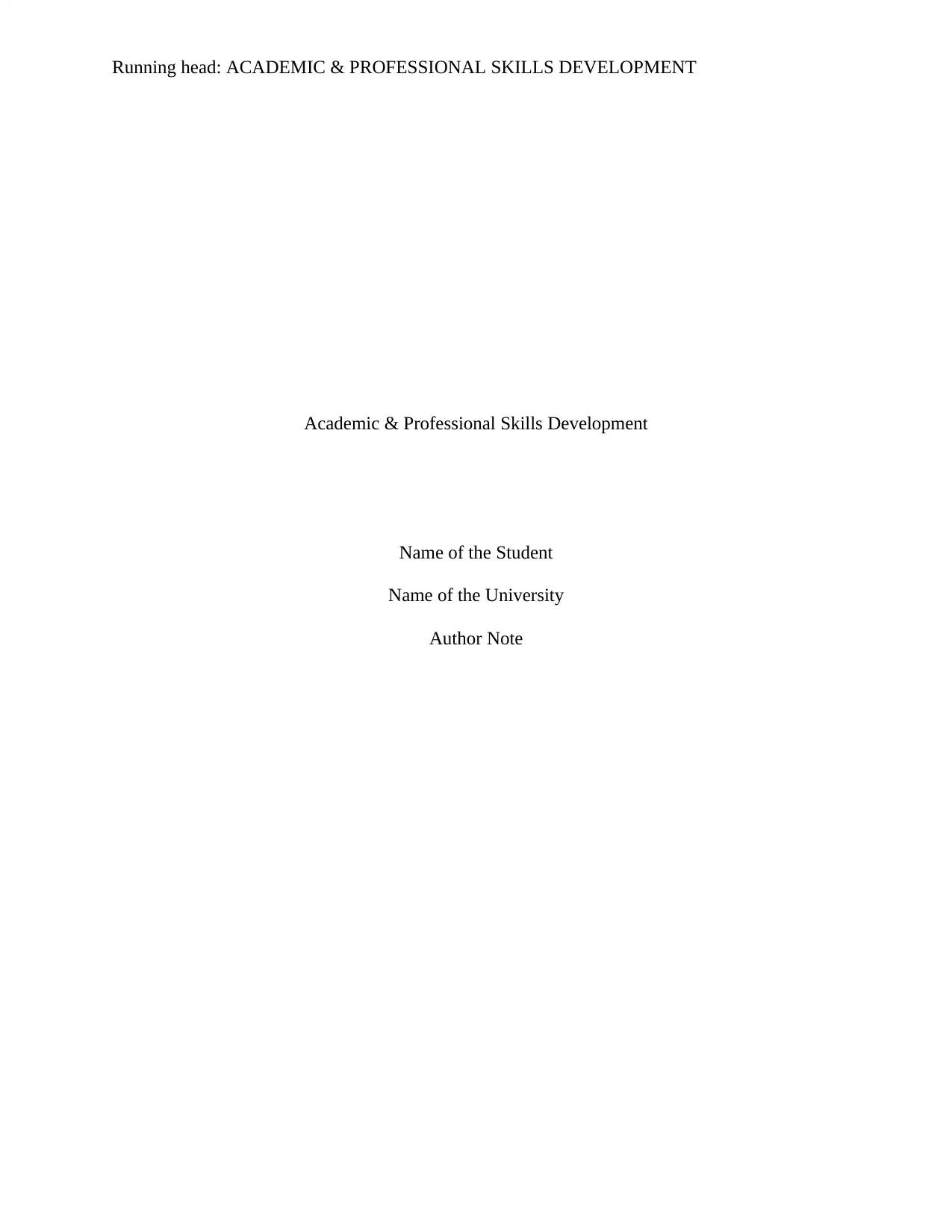
Running head: ACADEMIC & PROFESSIONAL SKILLS DEVELOPMENT
Academic & Professional Skills Development
Name of the Student
Name of the University
Author Note
Academic & Professional Skills Development
Name of the Student
Name of the University
Author Note
Paraphrase This Document
Need a fresh take? Get an instant paraphrase of this document with our AI Paraphraser
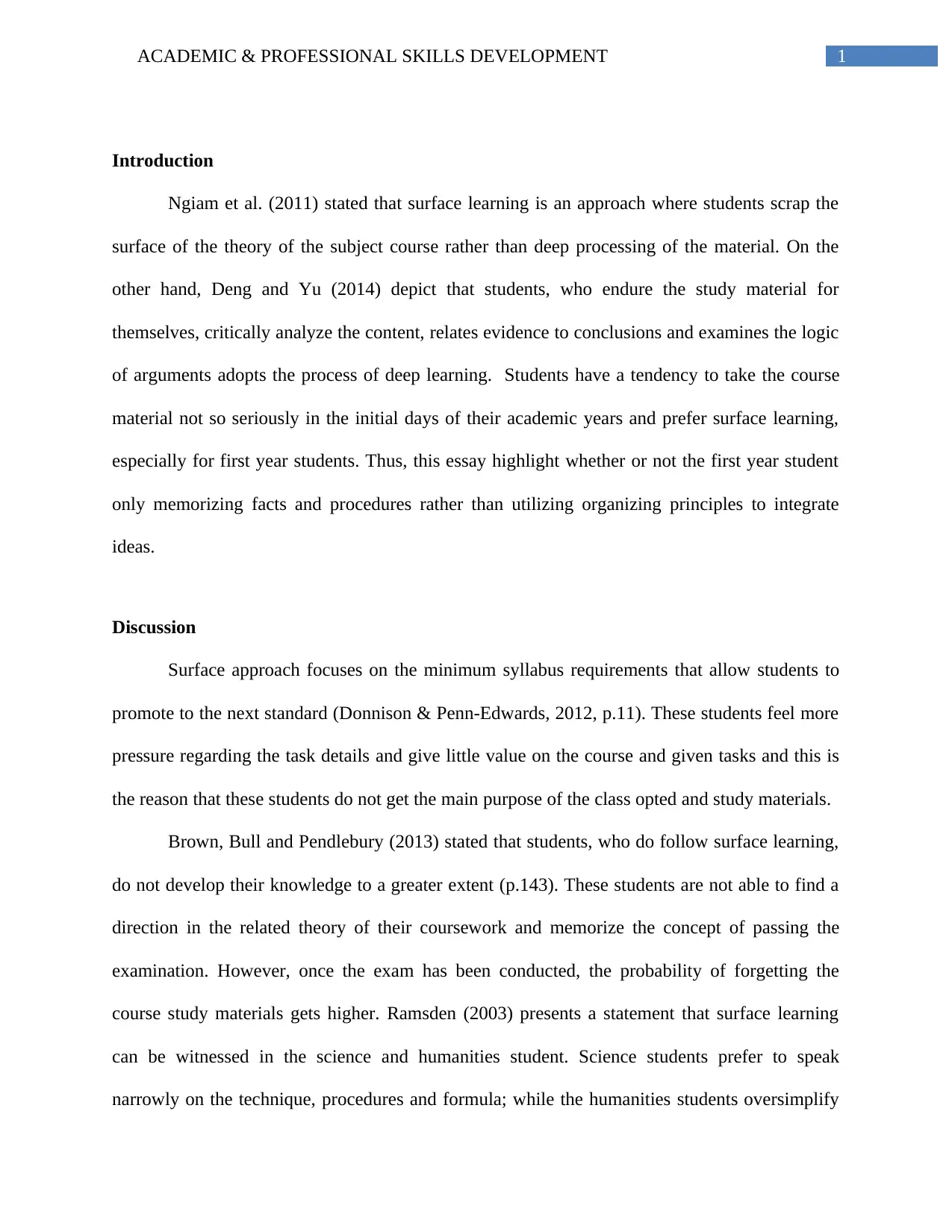
1ACADEMIC & PROFESSIONAL SKILLS DEVELOPMENT
Introduction
Ngiam et al. (2011) stated that surface learning is an approach where students scrap the
surface of the theory of the subject course rather than deep processing of the material. On the
other hand, Deng and Yu (2014) depict that students, who endure the study material for
themselves, critically analyze the content, relates evidence to conclusions and examines the logic
of arguments adopts the process of deep learning. Students have a tendency to take the course
material not so seriously in the initial days of their academic years and prefer surface learning,
especially for first year students. Thus, this essay highlight whether or not the first year student
only memorizing facts and procedures rather than utilizing organizing principles to integrate
ideas.
Discussion
Surface approach focuses on the minimum syllabus requirements that allow students to
promote to the next standard (Donnison & Penn-Edwards, 2012, p.11). These students feel more
pressure regarding the task details and give little value on the course and given tasks and this is
the reason that these students do not get the main purpose of the class opted and study materials.
Brown, Bull and Pendlebury (2013) stated that students, who do follow surface learning,
do not develop their knowledge to a greater extent (p.143). These students are not able to find a
direction in the related theory of their coursework and memorize the concept of passing the
examination. However, once the exam has been conducted, the probability of forgetting the
course study materials gets higher. Ramsden (2003) presents a statement that surface learning
can be witnessed in the science and humanities student. Science students prefer to speak
narrowly on the technique, procedures and formula; while the humanities students oversimplify
Introduction
Ngiam et al. (2011) stated that surface learning is an approach where students scrap the
surface of the theory of the subject course rather than deep processing of the material. On the
other hand, Deng and Yu (2014) depict that students, who endure the study material for
themselves, critically analyze the content, relates evidence to conclusions and examines the logic
of arguments adopts the process of deep learning. Students have a tendency to take the course
material not so seriously in the initial days of their academic years and prefer surface learning,
especially for first year students. Thus, this essay highlight whether or not the first year student
only memorizing facts and procedures rather than utilizing organizing principles to integrate
ideas.
Discussion
Surface approach focuses on the minimum syllabus requirements that allow students to
promote to the next standard (Donnison & Penn-Edwards, 2012, p.11). These students feel more
pressure regarding the task details and give little value on the course and given tasks and this is
the reason that these students do not get the main purpose of the class opted and study materials.
Brown, Bull and Pendlebury (2013) stated that students, who do follow surface learning,
do not develop their knowledge to a greater extent (p.143). These students are not able to find a
direction in the related theory of their coursework and memorize the concept of passing the
examination. However, once the exam has been conducted, the probability of forgetting the
course study materials gets higher. Ramsden (2003) presents a statement that surface learning
can be witnessed in the science and humanities student. Science students prefer to speak
narrowly on the technique, procedures and formula; while the humanities students oversimplify
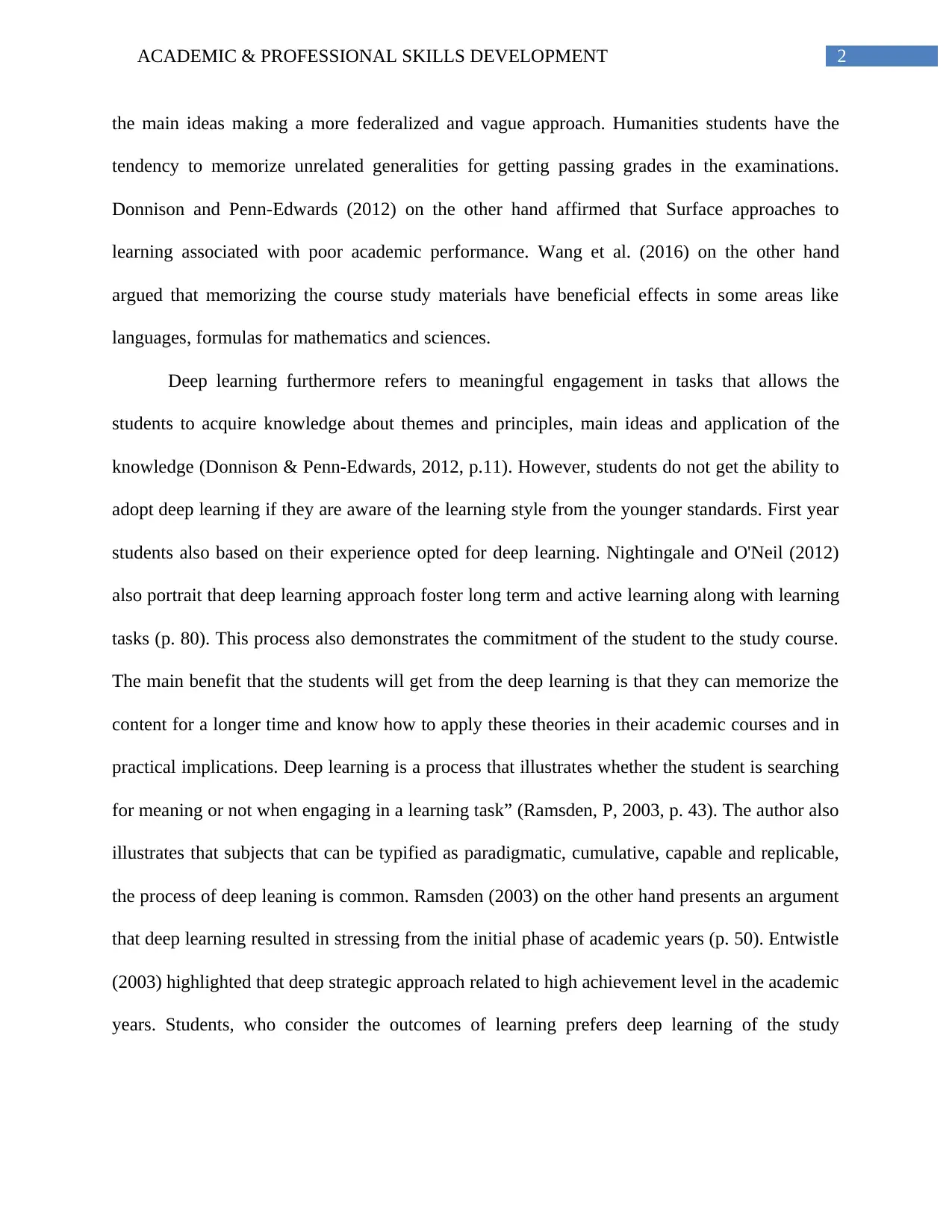
2ACADEMIC & PROFESSIONAL SKILLS DEVELOPMENT
the main ideas making a more federalized and vague approach. Humanities students have the
tendency to memorize unrelated generalities for getting passing grades in the examinations.
Donnison and Penn-Edwards (2012) on the other hand affirmed that Surface approaches to
learning associated with poor academic performance. Wang et al. (2016) on the other hand
argued that memorizing the course study materials have beneficial effects in some areas like
languages, formulas for mathematics and sciences.
Deep learning furthermore refers to meaningful engagement in tasks that allows the
students to acquire knowledge about themes and principles, main ideas and application of the
knowledge (Donnison & Penn-Edwards, 2012, p.11). However, students do not get the ability to
adopt deep learning if they are aware of the learning style from the younger standards. First year
students also based on their experience opted for deep learning. Nightingale and O'Neil (2012)
also portrait that deep learning approach foster long term and active learning along with learning
tasks (p. 80). This process also demonstrates the commitment of the student to the study course.
The main benefit that the students will get from the deep learning is that they can memorize the
content for a longer time and know how to apply these theories in their academic courses and in
practical implications. Deep learning is a process that illustrates whether the student is searching
for meaning or not when engaging in a learning task” (Ramsden, P, 2003, p. 43). The author also
illustrates that subjects that can be typified as paradigmatic, cumulative, capable and replicable,
the process of deep leaning is common. Ramsden (2003) on the other hand presents an argument
that deep learning resulted in stressing from the initial phase of academic years (p. 50). Entwistle
(2003) highlighted that deep strategic approach related to high achievement level in the academic
years. Students, who consider the outcomes of learning prefers deep learning of the study
the main ideas making a more federalized and vague approach. Humanities students have the
tendency to memorize unrelated generalities for getting passing grades in the examinations.
Donnison and Penn-Edwards (2012) on the other hand affirmed that Surface approaches to
learning associated with poor academic performance. Wang et al. (2016) on the other hand
argued that memorizing the course study materials have beneficial effects in some areas like
languages, formulas for mathematics and sciences.
Deep learning furthermore refers to meaningful engagement in tasks that allows the
students to acquire knowledge about themes and principles, main ideas and application of the
knowledge (Donnison & Penn-Edwards, 2012, p.11). However, students do not get the ability to
adopt deep learning if they are aware of the learning style from the younger standards. First year
students also based on their experience opted for deep learning. Nightingale and O'Neil (2012)
also portrait that deep learning approach foster long term and active learning along with learning
tasks (p. 80). This process also demonstrates the commitment of the student to the study course.
The main benefit that the students will get from the deep learning is that they can memorize the
content for a longer time and know how to apply these theories in their academic courses and in
practical implications. Deep learning is a process that illustrates whether the student is searching
for meaning or not when engaging in a learning task” (Ramsden, P, 2003, p. 43). The author also
illustrates that subjects that can be typified as paradigmatic, cumulative, capable and replicable,
the process of deep leaning is common. Ramsden (2003) on the other hand presents an argument
that deep learning resulted in stressing from the initial phase of academic years (p. 50). Entwistle
(2003) highlighted that deep strategic approach related to high achievement level in the academic
years. Students, who consider the outcomes of learning prefers deep learning of the study
⊘ This is a preview!⊘
Do you want full access?
Subscribe today to unlock all pages.

Trusted by 1+ million students worldwide
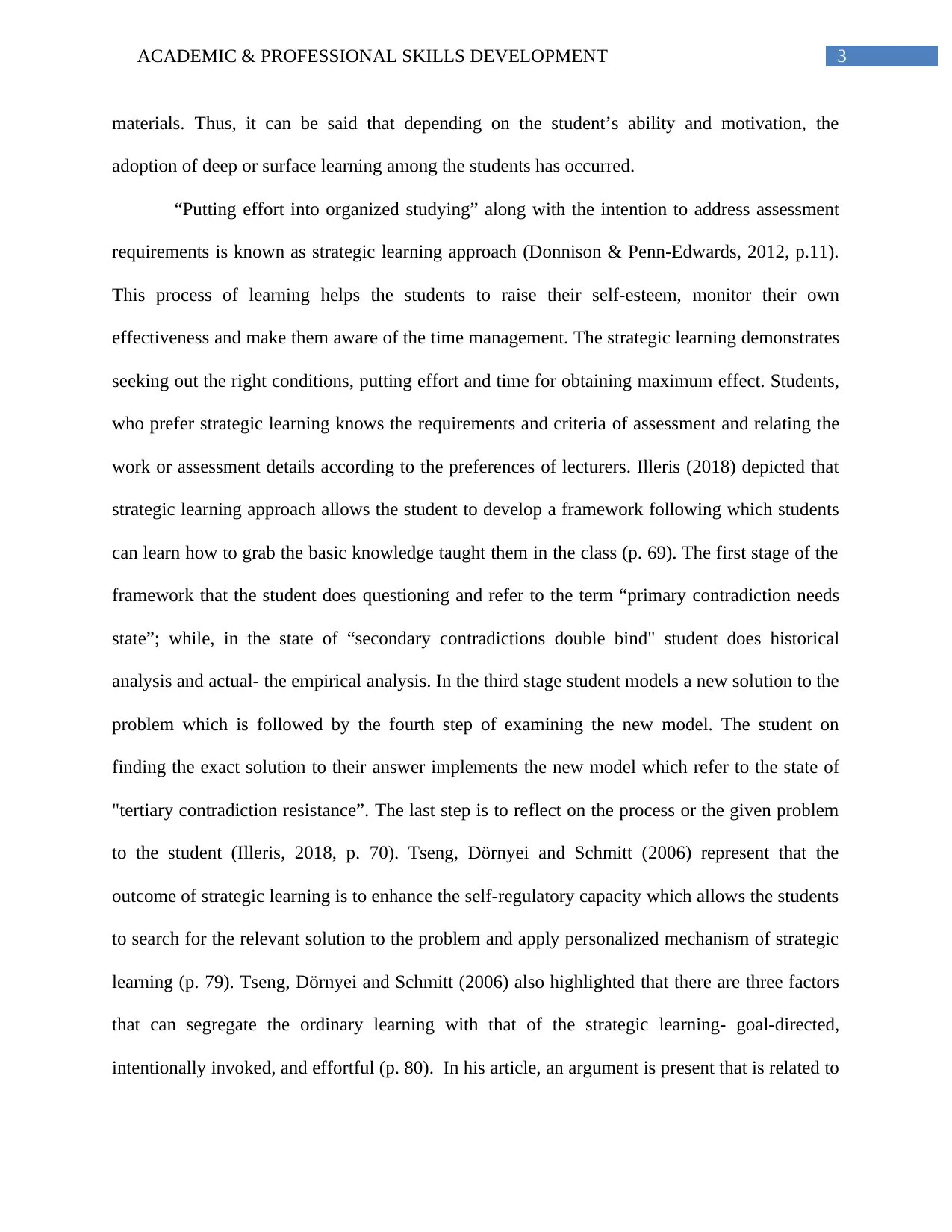
3ACADEMIC & PROFESSIONAL SKILLS DEVELOPMENT
materials. Thus, it can be said that depending on the student’s ability and motivation, the
adoption of deep or surface learning among the students has occurred.
“Putting effort into organized studying” along with the intention to address assessment
requirements is known as strategic learning approach (Donnison & Penn-Edwards, 2012, p.11).
This process of learning helps the students to raise their self-esteem, monitor their own
effectiveness and make them aware of the time management. The strategic learning demonstrates
seeking out the right conditions, putting effort and time for obtaining maximum effect. Students,
who prefer strategic learning knows the requirements and criteria of assessment and relating the
work or assessment details according to the preferences of lecturers. Illeris (2018) depicted that
strategic learning approach allows the student to develop a framework following which students
can learn how to grab the basic knowledge taught them in the class (p. 69). The first stage of the
framework that the student does questioning and refer to the term “primary contradiction needs
state”; while, in the state of “secondary contradictions double bind" student does historical
analysis and actual- the empirical analysis. In the third stage student models a new solution to the
problem which is followed by the fourth step of examining the new model. The student on
finding the exact solution to their answer implements the new model which refer to the state of
"tertiary contradiction resistance”. The last step is to reflect on the process or the given problem
to the student (Illeris, 2018, p. 70). Tseng, Dörnyei and Schmitt (2006) represent that the
outcome of strategic learning is to enhance the self-regulatory capacity which allows the students
to search for the relevant solution to the problem and apply personalized mechanism of strategic
learning (p. 79). Tseng, Dörnyei and Schmitt (2006) also highlighted that there are three factors
that can segregate the ordinary learning with that of the strategic learning- goal-directed,
intentionally invoked, and effortful (p. 80). In his article, an argument is present that is related to
materials. Thus, it can be said that depending on the student’s ability and motivation, the
adoption of deep or surface learning among the students has occurred.
“Putting effort into organized studying” along with the intention to address assessment
requirements is known as strategic learning approach (Donnison & Penn-Edwards, 2012, p.11).
This process of learning helps the students to raise their self-esteem, monitor their own
effectiveness and make them aware of the time management. The strategic learning demonstrates
seeking out the right conditions, putting effort and time for obtaining maximum effect. Students,
who prefer strategic learning knows the requirements and criteria of assessment and relating the
work or assessment details according to the preferences of lecturers. Illeris (2018) depicted that
strategic learning approach allows the student to develop a framework following which students
can learn how to grab the basic knowledge taught them in the class (p. 69). The first stage of the
framework that the student does questioning and refer to the term “primary contradiction needs
state”; while, in the state of “secondary contradictions double bind" student does historical
analysis and actual- the empirical analysis. In the third stage student models a new solution to the
problem which is followed by the fourth step of examining the new model. The student on
finding the exact solution to their answer implements the new model which refer to the state of
"tertiary contradiction resistance”. The last step is to reflect on the process or the given problem
to the student (Illeris, 2018, p. 70). Tseng, Dörnyei and Schmitt (2006) represent that the
outcome of strategic learning is to enhance the self-regulatory capacity which allows the students
to search for the relevant solution to the problem and apply personalized mechanism of strategic
learning (p. 79). Tseng, Dörnyei and Schmitt (2006) also highlighted that there are three factors
that can segregate the ordinary learning with that of the strategic learning- goal-directed,
intentionally invoked, and effortful (p. 80). In his article, an argument is present that is related to
Paraphrase This Document
Need a fresh take? Get an instant paraphrase of this document with our AI Paraphraser
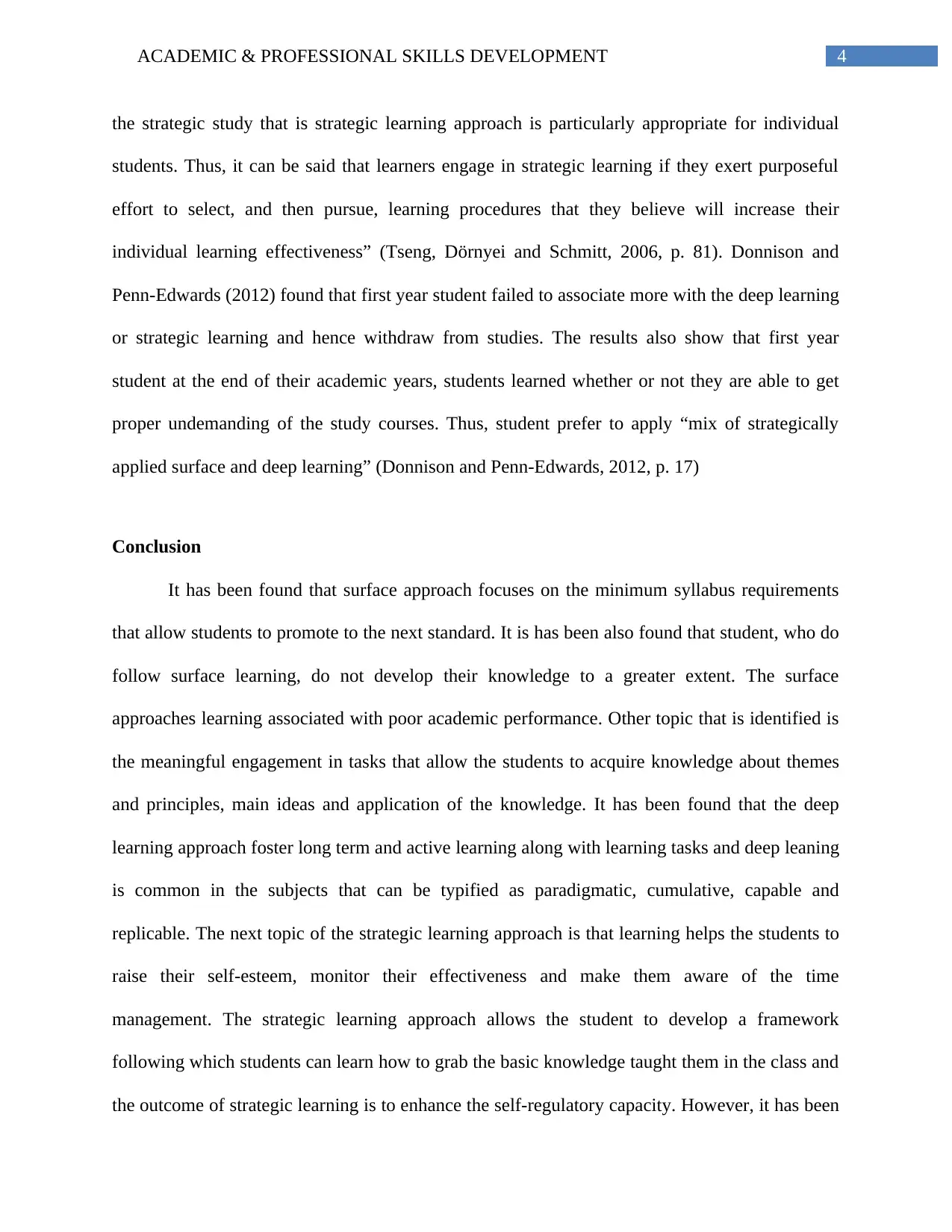
4ACADEMIC & PROFESSIONAL SKILLS DEVELOPMENT
the strategic study that is strategic learning approach is particularly appropriate for individual
students. Thus, it can be said that learners engage in strategic learning if they exert purposeful
effort to select, and then pursue, learning procedures that they believe will increase their
individual learning effectiveness” (Tseng, Dörnyei and Schmitt, 2006, p. 81). Donnison and
Penn-Edwards (2012) found that first year student failed to associate more with the deep learning
or strategic learning and hence withdraw from studies. The results also show that first year
student at the end of their academic years, students learned whether or not they are able to get
proper undemanding of the study courses. Thus, student prefer to apply “mix of strategically
applied surface and deep learning” (Donnison and Penn-Edwards, 2012, p. 17)
Conclusion
It has been found that surface approach focuses on the minimum syllabus requirements
that allow students to promote to the next standard. It is has been also found that student, who do
follow surface learning, do not develop their knowledge to a greater extent. The surface
approaches learning associated with poor academic performance. Other topic that is identified is
the meaningful engagement in tasks that allow the students to acquire knowledge about themes
and principles, main ideas and application of the knowledge. It has been found that the deep
learning approach foster long term and active learning along with learning tasks and deep leaning
is common in the subjects that can be typified as paradigmatic, cumulative, capable and
replicable. The next topic of the strategic learning approach is that learning helps the students to
raise their self-esteem, monitor their effectiveness and make them aware of the time
management. The strategic learning approach allows the student to develop a framework
following which students can learn how to grab the basic knowledge taught them in the class and
the outcome of strategic learning is to enhance the self-regulatory capacity. However, it has been
the strategic study that is strategic learning approach is particularly appropriate for individual
students. Thus, it can be said that learners engage in strategic learning if they exert purposeful
effort to select, and then pursue, learning procedures that they believe will increase their
individual learning effectiveness” (Tseng, Dörnyei and Schmitt, 2006, p. 81). Donnison and
Penn-Edwards (2012) found that first year student failed to associate more with the deep learning
or strategic learning and hence withdraw from studies. The results also show that first year
student at the end of their academic years, students learned whether or not they are able to get
proper undemanding of the study courses. Thus, student prefer to apply “mix of strategically
applied surface and deep learning” (Donnison and Penn-Edwards, 2012, p. 17)
Conclusion
It has been found that surface approach focuses on the minimum syllabus requirements
that allow students to promote to the next standard. It is has been also found that student, who do
follow surface learning, do not develop their knowledge to a greater extent. The surface
approaches learning associated with poor academic performance. Other topic that is identified is
the meaningful engagement in tasks that allow the students to acquire knowledge about themes
and principles, main ideas and application of the knowledge. It has been found that the deep
learning approach foster long term and active learning along with learning tasks and deep leaning
is common in the subjects that can be typified as paradigmatic, cumulative, capable and
replicable. The next topic of the strategic learning approach is that learning helps the students to
raise their self-esteem, monitor their effectiveness and make them aware of the time
management. The strategic learning approach allows the student to develop a framework
following which students can learn how to grab the basic knowledge taught them in the class and
the outcome of strategic learning is to enhance the self-regulatory capacity. However, it has been
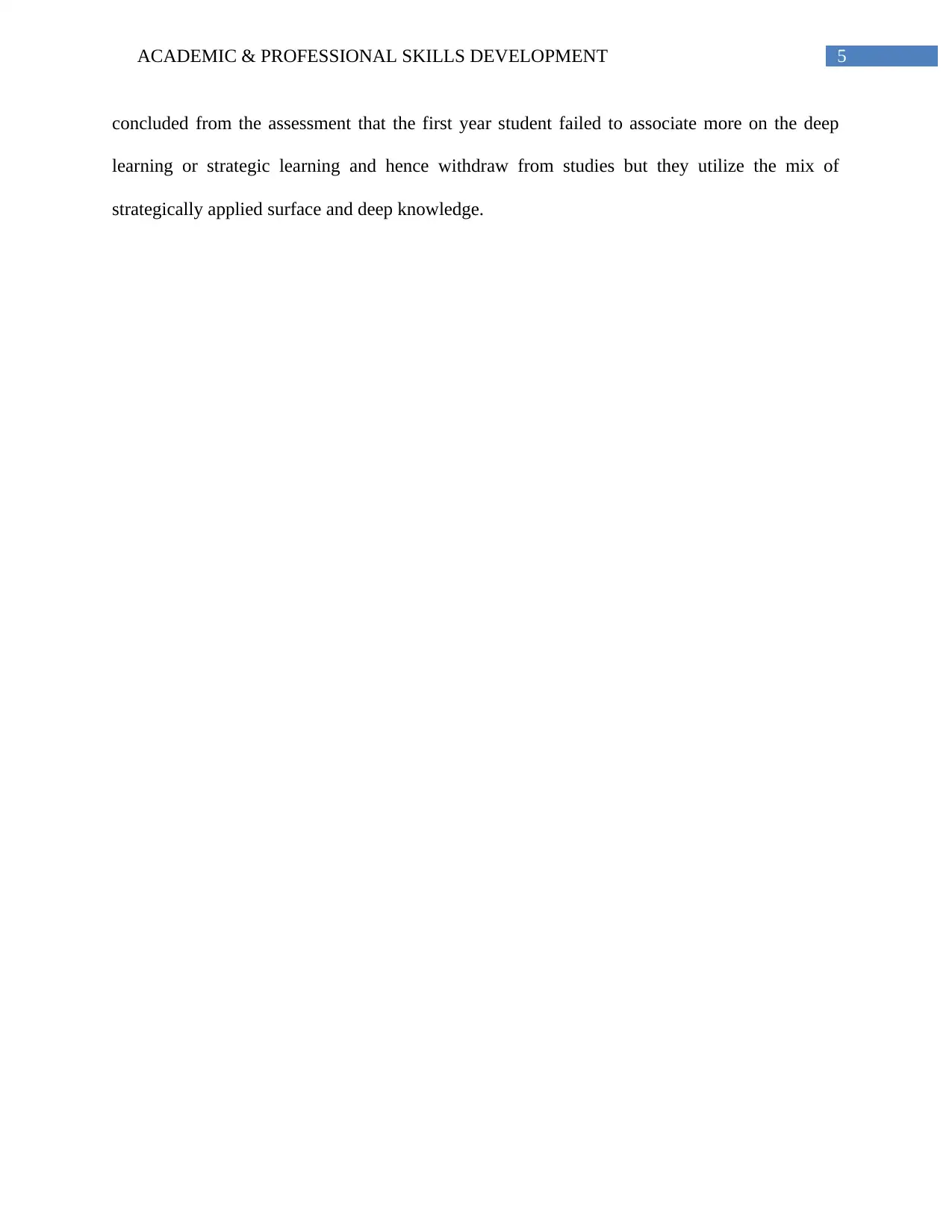
5ACADEMIC & PROFESSIONAL SKILLS DEVELOPMENT
concluded from the assessment that the first year student failed to associate more on the deep
learning or strategic learning and hence withdraw from studies but they utilize the mix of
strategically applied surface and deep knowledge.
concluded from the assessment that the first year student failed to associate more on the deep
learning or strategic learning and hence withdraw from studies but they utilize the mix of
strategically applied surface and deep knowledge.
⊘ This is a preview!⊘
Do you want full access?
Subscribe today to unlock all pages.

Trusted by 1+ million students worldwide
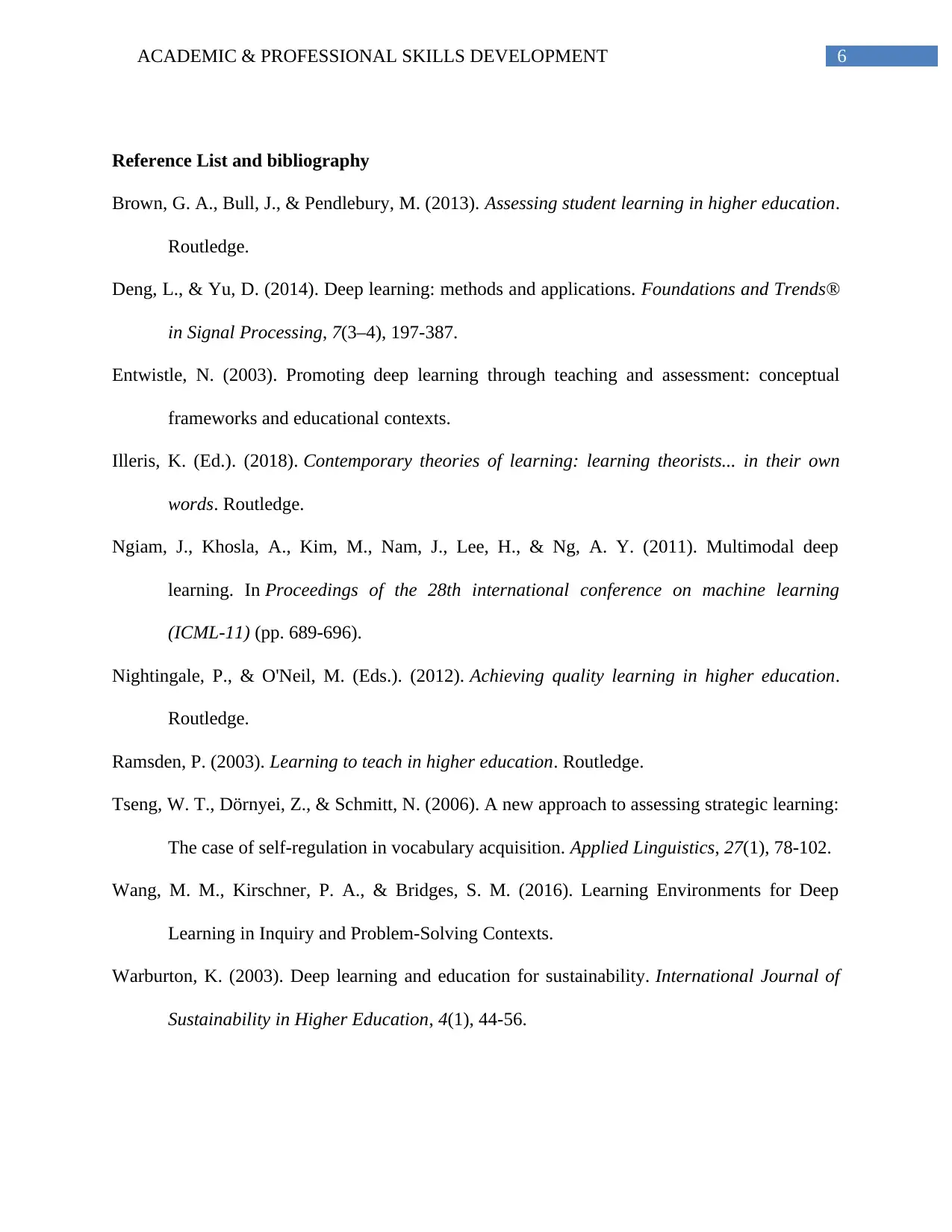
6ACADEMIC & PROFESSIONAL SKILLS DEVELOPMENT
Reference List and bibliography
Brown, G. A., Bull, J., & Pendlebury, M. (2013). Assessing student learning in higher education.
Routledge.
Deng, L., & Yu, D. (2014). Deep learning: methods and applications. Foundations and Trends®
in Signal Processing, 7(3–4), 197-387.
Entwistle, N. (2003). Promoting deep learning through teaching and assessment: conceptual
frameworks and educational contexts.
Illeris, K. (Ed.). (2018). Contemporary theories of learning: learning theorists... in their own
words. Routledge.
Ngiam, J., Khosla, A., Kim, M., Nam, J., Lee, H., & Ng, A. Y. (2011). Multimodal deep
learning. In Proceedings of the 28th international conference on machine learning
(ICML-11) (pp. 689-696).
Nightingale, P., & O'Neil, M. (Eds.). (2012). Achieving quality learning in higher education.
Routledge.
Ramsden, P. (2003). Learning to teach in higher education. Routledge.
Tseng, W. T., Dörnyei, Z., & Schmitt, N. (2006). A new approach to assessing strategic learning:
The case of self-regulation in vocabulary acquisition. Applied Linguistics, 27(1), 78-102.
Wang, M. M., Kirschner, P. A., & Bridges, S. M. (2016). Learning Environments for Deep
Learning in Inquiry and Problem-Solving Contexts.
Warburton, K. (2003). Deep learning and education for sustainability. International Journal of
Sustainability in Higher Education, 4(1), 44-56.
Reference List and bibliography
Brown, G. A., Bull, J., & Pendlebury, M. (2013). Assessing student learning in higher education.
Routledge.
Deng, L., & Yu, D. (2014). Deep learning: methods and applications. Foundations and Trends®
in Signal Processing, 7(3–4), 197-387.
Entwistle, N. (2003). Promoting deep learning through teaching and assessment: conceptual
frameworks and educational contexts.
Illeris, K. (Ed.). (2018). Contemporary theories of learning: learning theorists... in their own
words. Routledge.
Ngiam, J., Khosla, A., Kim, M., Nam, J., Lee, H., & Ng, A. Y. (2011). Multimodal deep
learning. In Proceedings of the 28th international conference on machine learning
(ICML-11) (pp. 689-696).
Nightingale, P., & O'Neil, M. (Eds.). (2012). Achieving quality learning in higher education.
Routledge.
Ramsden, P. (2003). Learning to teach in higher education. Routledge.
Tseng, W. T., Dörnyei, Z., & Schmitt, N. (2006). A new approach to assessing strategic learning:
The case of self-regulation in vocabulary acquisition. Applied Linguistics, 27(1), 78-102.
Wang, M. M., Kirschner, P. A., & Bridges, S. M. (2016). Learning Environments for Deep
Learning in Inquiry and Problem-Solving Contexts.
Warburton, K. (2003). Deep learning and education for sustainability. International Journal of
Sustainability in Higher Education, 4(1), 44-56.
1 out of 7
Related Documents
Your All-in-One AI-Powered Toolkit for Academic Success.
+13062052269
info@desklib.com
Available 24*7 on WhatsApp / Email
![[object Object]](/_next/static/media/star-bottom.7253800d.svg)
Unlock your academic potential
Copyright © 2020–2025 A2Z Services. All Rights Reserved. Developed and managed by ZUCOL.




